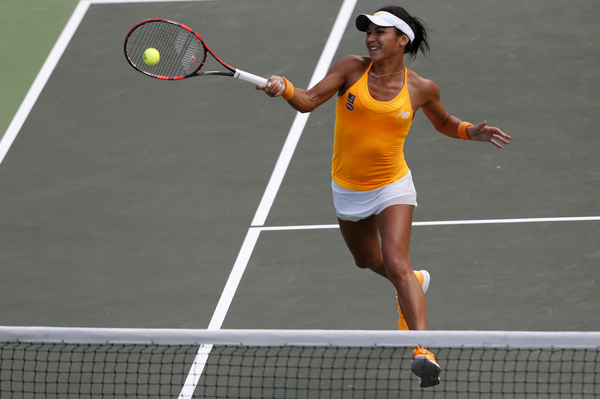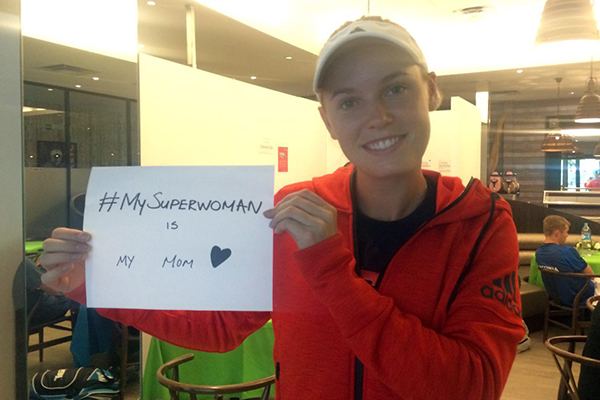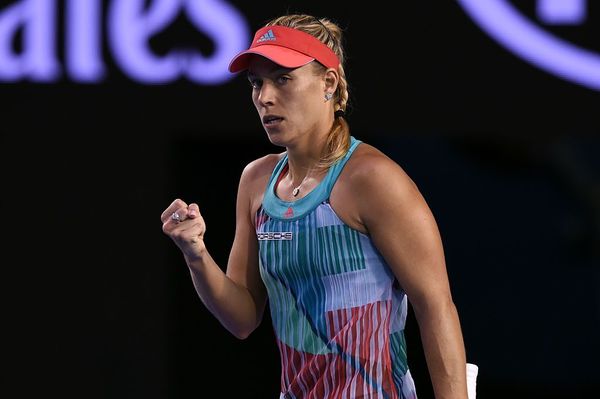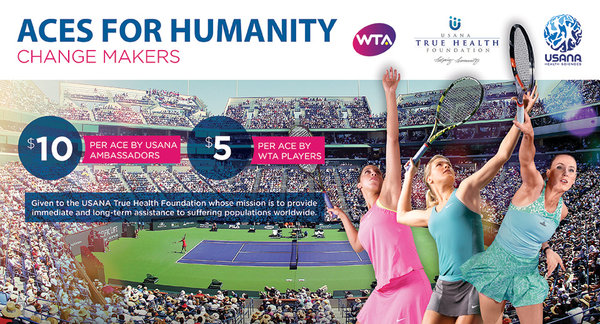1. Can Simona Halep turn her 2016 around with a title defense?
It has been a rough season thus far for Romania’s Simona Halep; beginning the year ranked No.2 in the world, Halep has lost five of her last six matches – though she earned a big three-set win playing Fed Cup at home against Petra Kvitova.
“I lost a few matches at the beginning of the year and I lost my confidence a little bit,” she said after unveiling a mural of herself as the BNP Paribas Open defending champion, “but those were because I was sick and couldn’t practice. Now I’m healthy and I feel great and I’m waiting to start the tournament.”
Halep hasn’t played her best tennis of late, but she rarely needed her A game during last year’s title run, relying on an indomitable fighting spirit to recover from a set and a break down to defea former No.1 Jelena Jankovic in the final. Practicing with coach Darren Cahill, the Romanian was joined by a pair of tennis legends in Andre Agassi and 22-time Grand Slam champion Steffi Graf.
“It was a great experience; they gave great advice and I really want to thank them for helping me. I need to change my thoughts to be more like big champions.”
Opening against a qualifier or Vania King – who is on the way back from a back injury that kept her off the court for most of 2015 – in the second round, the No.5 seed has a tough road back to the final, potentially facing No.10 seed Venus Williams and World No.1 Serena Williams before the semifinals. But Halep sounds in good spirits, enjoying the perks of being the defending champion.
“I went to the locker rooms and there were no more lockers left for me. But they said I have a special room where the champions are, so I went there and I felt very special. For a minute I felt very special in my mind!”
2. Can Venus cap her return to Indian Wells with a quarterfinal face-off with sister Serena?
Speaking of the Williams sisters, Serena leads the field and opens against a qualifier or Irina-Camelia Begu following a first round bye. The American is playing her first tournament since the Australian Open, where she roared into the final only to be stunned by Angelique Kerber – who is seeded second in Indian Wells.
With Kristina Mladenovic, Anastasia Pavlyuchenkova and reigning Dubai Duty Free Tennis Championships winner Sara Errani all in her section, look for Serena to shake off the rust early in the hopes of winning her first BNP Paribas Open title since 2001.
Venus has rebounded from her slow start in Australia (where she went 0-2 in Auckland and Melbourne) with an emphatic run to the Taiwan Open title. The No.10 seed also enjoys a bye into the second round of her first appearance in Indian Wells since 2001, and could start her tournament against a qualifier or Brazil’s Teliana Pereira. The elder Williams hasn’t beaten Halep since 2013, but the American leads their overall head-to-head 3-1 – something to remember should they meet in the round of 16.
Venus and Serena thrilled the US Open crowd in their most recent encounter; a repeat in the quarterfinals could be a highlight of the fortnight.

3. Can Kerber cruise into her third final of 2016?
Angelique Kerber endured a hiccup in her first WTA match since winning the Australian Open, dropping out to Zheng Saisai at the Qatar Total Open, but the German could well be back to her best in the California desert. At the bottom of the draw, her second round match-up will be one of a pair of powerful Czechs: Denisa Allertova or Petra Cetkovska.
Seeded to face fellow Australian Open semifinalist Johanna Konta in the third round, Kerber has most of the season’s most consistent performers in her quarter, with a potential quarterfinal against Doha’s champion Carla Suárez Navarro or Sloane Stephens, the only woman to win multiple titles in 2016 with wins in Auckland and Acapulco. Also in her section is Ana Ivanovic – who could open her tournament against the winner of Camila Giorgi or Julia Goerges – and Karolina Pliskova, who struggled through the Middle East swing after leading her country to a Fed Cup win over Romania.
Kerber made back-to-back semifinals at the BNP Paribas Open in 2012 and 2013, but didn’t win a match in either of her last two appearances; still feeling the kind of confidence that took her to a maiden Grand Slam title, the veteran will be eager to buck the trend.
4. Can Agnieszka Radwanska fulfill her big title potential?
Radwanska has largely been the one to beat since last year’s US Open; the Pole has won four titles since September – including the BNP Paribas WTA Finals Singapore presented by SC Global – and reached the semifinals of the Australian Open.
Despite turning heads in a thrilling three-set win against Roberta Vinci in the quarterfinals of Qatar, the crafty Radwanska showed worrying signs of fatigue – be it physical or mental – in her flat semifinal loss to Suárez Navarro the next day. To make it through a two week tournament, the World No.3 will have to leave the extended highlight reel at home, especially with a potential rematch with Serena Williams looming just before the finals weekend.
When they played in Australia, Radwanska had few answers for a Serena playing at her peak, but the Pole will do herself no favors by getting in epic grindfests with Dominika Cibulkova (her potential second round opponent) or any of the seeds in her section: Monica Niculescu, 2015 finalist Jelena Jankovic, or Apia International Sydney champion Svetlana Kuznetsova.

5. How well can the kids table tread water during adult swim?
No.7 seed Belinda Bencic is the highest ranked of three 18-year-olds in the Top 50, but any one of the young stars can cause a stir over the next two weeks. Opening against either 21-year-old Nao Hibino or 22-year-old wildcard Lauren Davis, the reigning Rogers Cup champion is in an interesting quarter anchored by fellow youngster and 2015 Wimbledon finalist Garbiñe Muguruza – who is seeded No.4 – but peppered with a mix of new and familiar faces.
Bencic is seeded to play Daria Gavrilova, who is up to a career-high ranking of No.33, and could play one of BMW Malaysian Open champion Elina Svitolina or St. Petersburg Ladies Trophy winner and oldest Top 10 debutante, Roberta Vinci.
A third round match-up of veritable veterans is also on the menu as former No.1s Victoria Azarenka and Caroline Wozniacki are projected to face off following their opening rounds, with Muguruza a possible fourth round opponent. Azarenka is playing just her second tournament since her shocking Australian Open loss to Kerber, but her first since withdrawing from the Abierto Mexicano Telcel with a left wrist injury.
Daria Kasatkina is the other top ranked teen; the young Russian sits in the same section as Suárez Navarro and the same quarter as Stephens, who might end up with a blockbuster second round against former No.5 Eugenie Bouchard – should the Canadian win her first round against a qualifier. Opening against two-time champion and wildcard Daniela Hantuchova, Kasatkina hasn’t paid too much attention to where her rapid rise has left her in the rankings, and is excited to make her Indian Wells debut.
“I don’t care, really; I just go and play every match and I don’t watch the rankings. I just play. I’m getting some experience and every tournament and every match is helping me.”
One of the younger stars looking to kickstart her season is Anna Karolina Schmiedlova. The Slovak made her first Premier-level quarterfinal at last summer’s Western & Southern Open and was an alternate at the Huajin Securities WTA Elite Trophy Zhuhai. On hand for the draw ceremony, Schmiedlova hopes to start small and end up with something big.
“I didn’t have a really great start of the season, and I just really want to get back and play some more matches, win something to get more confidence now. I’m practicing a lot so I hope it will show up on the courts. I didn’t have big goals here; I just want to play good and show what I can do.”
The Favorites:
– Serena Williams: When she is at her best, she is unquestionably the best in any draw. The World No.1 shook off the disappointments from the end of last year to play some of her best tennis in Melbourne, and with six weeks of rest should be primed for another deep run in Indian Wells.
– Angelique Kerber: Capable of playing consistent tennis, the German will have to shift into a more aggressive mindset the farther she goes in the draw – particularly against Stephens or Suárez Navarro in the quarterfinals. Whether this is indeed a new Kerber may become apparent fairly quickly depending on her result here.
The Next Best Things:
– Agnieszka Radwanska: Radwanska hasn’t faced any early upsets in a while, and should she stay fresh heading into the later rounds, the No.3 seed could be make it into the final – but how things shake out in the Williams/Halep quarter may still determine where she finishes.
– Carla Suárez Navarro: The Spaniard impressed in the Middle East and assumed the role of the alpha to great success in Doha. Suárez Navarro has beaten Kerber on hardcourts before, and as she looks to break into the Top 5, will need to continue proving herself with big wins as she rockets up the rankings.
– Simona Halep: A confidence player, Halep may be feeling a bit more pressure after taking a look at her draw, but not being expected to defend her title may free her up, and if her time with Graf was half as inspiring as it was for Kerber last spring, the Romanian may have a fortnight to remember.

Dark Horses:
– Belinda Bencic: The teenager has had a flying start to 2016, and despite stumbling in the Middle East, the Swiss star has shown a champion’s mettle that tends to be rewarded with big titles.
– Sloane Stephens: With two titles already under her belt, Stephens is suddenly in search of a deep run at a major tournament – something that used to be her calling card. Should she get past Bouchard, the American has all the tools to succeed on this surface.
– Victoria Azarenka: Struggles with injury keep her lower on the list than she might have otherwise been given her stellar run to the Brisbane International title, but it will be interesting to see how Azarenka recovers from that loss in Melbourne; given how things panned out, the two-time Australian Open champion might feel she let an opportunity slip by. The next few weeks will undoubtedly be a big test for the Belarusian.
First week spoilers:
– Barbora Strycova (vs. Andrea Petkovic, second round)
– CoCo Vaneweghe (vs. Svetlana Kuznetsova, second round)
– Bethanie Mattek-Sands (vs. Elina Svitolina, second round)
– Zhang Shuai (vs. Caroline Wozniacki, second round)
Click here to see the full draw.
All photos courtesy of Getty Images.




















